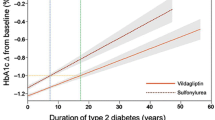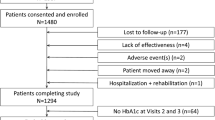Abstract
Ability to predict which patients might benefit more of therapy might facilitate personalization of treatment. The aim of this study was to obtain information about clinical characteristics which might predict the HbA1c response to DPP-4 inhibitors. We conducted an electronic search without restriction for randomized controlled trials (RCTs) involving DPP-4 inhibitors (vildagliptin, sitagliptin, saxagliptin, linagliptin, and alogliptin). RCTs were included if they lasted at least 12 weeks, reported the effect of DPP-4 inhibitors on HbA1c level, and the number of patients in any arm was >30. We did a meta-regression analysis. Seventy-eight articles were eligible, with 79 arms and 20,503 patients. For all arms, the decrease of HbA1c was −0.74 % (95 % CI −0.80 to −0.67 %), with considerable heterogeneity (I 2 = 97 %, P < 0.0001): the greatest HbA1c decrease was seen at 52 weeks (8 arms, 3,338 patients, −0.88 %, 95 % CI −1.10 to −0.66 %). In univariate meta-regression analysis, baseline HbA1c explained 22 % of variance of the HbA1c response to treatment, while fasting glucose and type of DPP-4 inhibitor explained an additional 19 and 12 %, respectively; age, duration of treatment, previous therapy, and type of statistical analysis of RCTs were without influence. In the multivariate meta-regression model, baseline HbA1c, fasting glucose, and type of DPP-4 inhibitor explained 61 % of total variance. The HbA1c response to DPP-4 inhibitors can be modulated mainly by baseline HbA1c and fasting glucose levels: a greater absolute reduction of baseline HbA1c is seen in patients with higher baseline HbA1c and lower fasting glucose level.



Similar content being viewed by others
References
D.R. Whiting, L. Guariguata, C. Weil, J. Shaw, IDF Diabetes Atlas: global estimates of the prevalence of diabetes for 2011 and 2030. Diabetes Res. Clin. Pract. 94, 311–321 (2011)
A.S. Go, D. Mozaffarian, V.L. Roger et al., On behalf of the American Heart Association Statistics Committee an Stroke Statistics Subcommittee. Heart disease and stroke statistics—2013 update: a report from the American Heart Association. Circulation 127, e6–e245 (2013)
K. Esposito, A. Ceriello, D. Giugliano, Does personalized diabetology overcome clinical uncertainty and therapeutic inertia in type 2 diabetes? Endocrine (2013). doi:10.1007/s12020-013-9918-x
T. Karagiannis, P. Paschos, K. Paletas, D.R. Matthews, A. Tsapas, Dipeptidyl peptidase-4 inhibitors for treatment of type 2 diabetes mellitus in the clinical setting: systematic review and meta-analysis. BMJ 344, e1369 (2013)
Y. Takeda, Y. Fujita, J. Honjo, T. Yanagimachi, H. Sakagami, Y. Takiyama, Y. Makino, A. Abiko, T.J. Kieffer, M. Haneda, Reduction of both beta cell death and alpha cell proliferation by dipeptidyl peptidase-4 inhibition in a streptozotocin-induced model of diabetes in mice. Diabetologia 55, 404–412 (2012)
M.A. Nauck, Incretin-based therapies for type 2 diabetes mellitus: properties, functions, and clinical implications. Am. J. Med. 124, S3–S18 (2011)
S.E. Inzucchi, R.M. Bergenstal, J.B. Buse, M. Diamant, E. Ferrannini, M. Nauck, A.L. Peters, A. Tsapas, R. Wender, Matthews, Management of hyperglycemia in type 2 diabetes: a patient centered approach: position statement of the American Diabetes Association (ADA) and the European Association for the study of diabetes (EASD). Diabetes Care 35, 1364–1379 (2012)
American Association of Clinical Endocrinologists, AACE comprehensive diabetes management algorithm. Endocr. Pract. 19, 331 (2013)
O.J. Phung, J.M. Scholle, M. Talwar, G.I. Coleman, Effect of noninsulin antidiabetic drugs added to metformin therapy on glycemic control, weight gain, and hypoglycemia in type 2 diabetes. JAMA 303, 1410–1418 (2010)
J.L. Gros, C.K. Kramer, C.B. Leitaõ, N. Hawkins, L.V. Viana, B.D. Schaan, L.C. Pinto, T.C. Rodrigues, M.J. Azevedo, For the Diabetes and Endocrinology Meta-analysis Group (DEMA): effect of antihyperglycemic agents added to metformin and a sulfonylurea on glycemic control and weight gain in type 2 diabetes: a network meta-analysis. Ann. Intern. Med. 154, 672–679 (2011)
K. Esposito, P. Chiodini, G. Bellastella, M.I. Maiorino, D. Giugliano, Proportion of patients at HbA1c target <7% with eight classes of antidiabetic drugs in type 2 diabetes: systematic review of 218 randomized controlled trials with 78,945 patients. Diabetes Obes. Metab. 14, 228–233 (2012)
J.J. Goldberger, A.E. Buxton, Personalized medicine vs guideline-based medicine. JAMA 309, 2559–2560 (2013)
A. Liberati, D.G. Altman, J. Tetzlaff, C. Mulrow, P.C. Gøtzsche, J.P. Ioannidis, M. Clarke, P.J. Devereaux, J. Kleijnen, D. Moher, The PRISMA statement for reporting systematic reviews and meta-analyses of studies that evaluate health care interventions: explanation and elaboration. Ann. Intern. Med. 151, W65–W94 (2009)
A.D. Deeks, M.J. Bradburn, Statistical methods for examining heterogeneity and combining results from several studies in meta-analysis, in Systematic Reviews in Health Care, ed. by M.D.-S.G. Egger, D.G. Altman (BMJ Publishing, London, 2001), pp. 285–312
H.C. Van Houwelingen, L.R. Arends, T. Stijne, Advanced methods in meta-analysis: multivariate approach and meta-regression. Stat. Med. 21, 589–624 (2002)
J.P. Higgins, S.G. Thompson, Controlling the risk of spurious findings from metaregression. Stat. Med. 23, 1663–1682 (2004)
M.K. Ali, K. McKeever Bullard, J.B. Saaddine, C.C. Cowie, G. Imperatore, E.W. Gregg, Achievement of goals in U.S. diabetes care, 1999–2010. N. Engl. J. Med. 368, 1613–1624 (2013)
I. Raz, M.C. Riddle, J. Rosenstock, J.B. Buse, S.E. Inzucchi, P.D. Home, S. Del Prato, E. Ferrannini, J.C. Chan, L.A. Leiter, D. Leroith, R. Defronzo, W.T. Cefalu, Personalized management of hyperglycemia in type 2 diabetes: reflections from a diabetes care editors’ expert forum. Diabetes Care 36, 1779–1788 (2013)
A.J. Scheen, G. Charpentier, C.J. Ostgren, A. Hellqvist, I. Gause-Nilsson, Efficacy and safety of saxagliptin in combination with metformin compared with sitagliptin in combination with metformin in adult patients with type 2 diabetes mellitus. Diabetes Metab. Res. Rev. 26, 540–549 (2010)
B. Göke, K. Hershon, D. Kerr, A. Calle Pascual, A. Schweizer, J. Foley, Q. Shao, S. Dejager, Efficacy and safety of vildagliptin monotherapy during 2-year treatment of drug-naïve patients with type 2 diabetes: comparison with metformin. Horm. Metab. Res. 40, 892–895 (2008)
D. Williams-Herman, J. Johnson, R. Teng, G. Golm, K.D. Kaufman, B.J. Goldstein, J.M. Amatruda, Efficacy and safety of sitagliptin and metformin as initial combination therapy and as monotherapy over 2 years in patients with type 2 diabetes. Diabetes Obes. Metab. 12, 442–451 (2010)
B.M. Scirica, D.L. Bhatt, E. Braunwald, P.G. Steg, J. Davidson, B. Hirshberg, P. Ohman, R. Frederich, S.D. Wiviott, E.B. Hoffman, M.A. Cavender, J.A. Udell, N.R. Desai, O. Mozenson, D.K. McGuire, K.K. Ray, L.A. Leiter, I. Raz, The SAVOR-TIMI 53 Steering Committee and Investigators, Saxagliptin and cardiovascular outcomes in patients with type 2 diabetes mellitus. N. Engl. J. Med. 369, 1317–1326 (2013)
W.B. White, C.P. Cannon, S.R. Heller, S.E. Nissen, R.M. Bergenstal, G.L. Bakris, A.T. Perez, P.R. Fleck, C.R. Mehta, S. Kupfer, C. Wilson, W.C. Cushman, F. Zannad, The EXAMINE Investigators, Alogliptin after acute coronary syndrome in patients with type 2 diabetes. N. Engl. J. Med. 369, 1327–1335 (2013)
C. Ess, F. Sudweeks, Culture, Technology, Communication: Towards an Intercultural Global Village (SUNY Press, Albany, 2001), p. 90
Acknowledgments
This study was partly funded by a grant from the Second University of Naples, Italy.
Conflict of interest
No potential conflicts of interest relevant to this article were reported.
Author information
Authors and Affiliations
Corresponding author
Electronic supplementary material
Below is the link to the electronic supplementary material.
Rights and permissions
About this article
Cite this article
Esposito, K., Chiodini, P., Capuano, A. et al. Baseline glycemic parameters predict the hemoglobin A1c response to DPP-4 inhibitors. Endocrine 46, 43–51 (2014). https://doi.org/10.1007/s12020-013-0090-0
Received:
Accepted:
Published:
Issue Date:
DOI: https://doi.org/10.1007/s12020-013-0090-0




